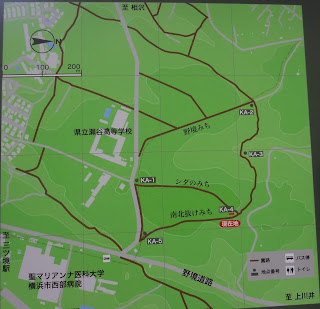When early winter comes, we can sometimes find bright orange fruits dangling within forests of Yokohama. By then, autumn leaves are ending, and the scenery in the forest turns into dark green and brown. So, the orange color stands out. It’s Trichosanthes cucumeroides, aka Japanese Snake Gourd, a climbing plant endemic in China and Japan. The fruit is well-known here, but not many people have seen flowers of them. Well, to have a fruit, a plant needs flowers, doesn’t it? Of course, Trichosanthes cucumeroides has flowers. The reason not many people have noticed them is, it opens only after sunset. Wondering into a dark forest is not a popular sport, and so flowers for Trichosanthes cucumeroides are not known widely. But, it does not mean the flowers are not seen actually. The case in point: one early August morning very near from my home, a typical suburb of Yokohama with lots of houses and concreted car roads, I noticed Trichosanthes cucumeroides is profusely blooming over a wire fence covering a culvert. They were flowering about 2m down from a parapet of the bridge of a main street, without being noticed by busy commuters of the city.
 |
| A
typical bush of Trichosanthes cucumeroides found in a autumn forest of Kanagawa. The orange dots in this photo are its fruits. |
 |
| Young flower buds of Trichosanthes
cucumeroides found in Niiharu Citizen Forest 新治市民の森 this July. The time of their flowering is August in Yokohama. |
When the sun rises, the flowers of Trichosanthes cucumeroides look like rolled-up cotton balls (and so is my photo.). The fully bloomed 5-petaled flower is like a white star with lots of complicated threads encircling the flower-body. When the sun set, their bud starts to open and completes in several minutes to show off their delicately-laced flower. They set up their night shop in haste for welcoming long-mouthed Sphingidae that can pollinate them in spite of a thin funnel-like structure of their pistils and stamens. Theirs is business of limited edition: after a week or so of opening, a flower of Trichosanthes cucumeroides closes its door. Hmmmmmmmm … They are like samba dancers of favelas in Rio de Janeiro. To stand out in dark summer nights, they have a strikingly white flower with halo-like ornament on their back that can be deployed quickly. All year long, they must have been preparing for their carnival of just a week. It’s a wonder of the nature how they manage to spread so swiftly such a complex structure without being entangled (; this You Tube video shows their process captured by a high-speed camera). They are strong. They don’t care the concreted space over a culvert. As long as there is some soil for them to establish, it’s OK. That’s amazing!
 |
| This is what I found early morning. |
 |
| They are looked like these before sun-set. |
Unlike its Indian cousin, Snake Gourd with long snake-like fruits, Japanese Snake Gourd has only a round fruit. It contains peculiarly-shaped seeds covered by slimy fibers. (The slime makes it easy for birds to spread the seeds as poops.) Some of our ancestors thought they were similar to a magic gavel, called a “Malletof Luck 打出の小槌” held by a legendary Buddhist monk of China named Hotei 布袋. Hotei symbolizes wealth and abundance and his mallet is a cornucopia that materializes fortune by just one swing. So! Seeds of Trichosanthes cucumeroides are a talisman that can invite lots of money to your wallet!!! And then, what’s good for your bank account is good news. Hence, the language of flowers for Trichosanthes cucumeroides in Japan is, “Good News,” and “Sincerity” which is desirable characteristics for bankers, of course. OK, OK, OK … Huh, another language for the flower? “Misandry.” Oh dear ... Why do these words coexists in Trichosanthes cucumeroides?
 |
| When
you open a fully-ripen fruit of Trichosanthes cucumeroides, it’s like this. |
 |
| It’s Japanese version of cornucopia. |
 |
| And
they are the seeds of Trichosanthes cucumeroides. For me, they look more like croissants … |
When I was a kid for a kindergarten decades ago, the area I’ve found flowers of Japanese snake gourd this summer was a vacant semi-riverbed covered with lots weeds. I remember we played hide-and-seek in the untamed grass field, could be with Trichosanthes cucumeroides. That was a thrilling sport for 4 years’ olds. Come to think of it, I did not have any “shocking” feeling to find Trichosanthes cucumeroides anywhere in the forest. I may have been accustomed to be around them thanks to the hide-and-seek … Before long, housing development drained our playground completely, built a well-paved road connected to the main street, and made sprouting more than 10 detached houses along the alley. By then, we kids were busy in homework, entrance exams for grade schools, and jobs. The beloved place for hide-and-seek was completely disappeared together with our memory … so I thought. Then, this summer, I’ve suddenly noticed Trichosanthes cucumeroides flowering under the concrete bridge, almost hiding from the eyes of busy city folks. It’s like, “A Man-hater night lady wears a gorgeous white dress with intricately laced collar. She may have a superpower of attracting large sum of money. Though, honestly she does not care to attract humans whose utility for her is far lower than that of Sphingidae.” Now I found them in a concreted and sweltered city. Are they doing another hide-and-seek?































































